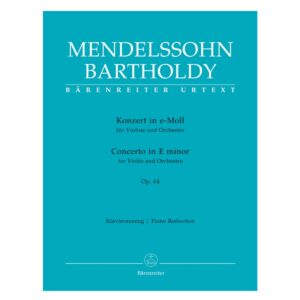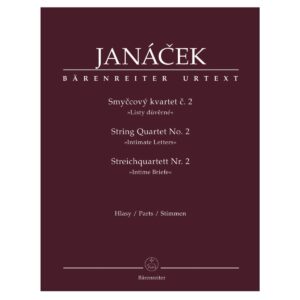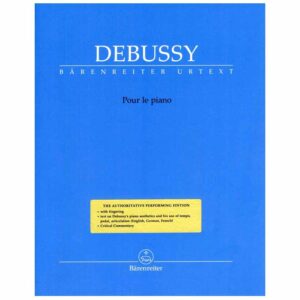ISOLUTION
-
-
Martinu – Concerto for 2 Violins And Orchestra
Martinů, Bohuslav Jan – Concerto
for 2 Violins and Orchestra
(Piano Reduction)
Editor: Šolc, Karel
Score Pages: 61
Violin Part Pages: 16 x 2
Language: English, German, Czech
Publisher: Bärenreiter€32,90€36,60Martinu – Concerto for 2 Violins And Orchestra
€32,90€36,60Διαθέσιμο σε 1-3 ημέρες
-
Bach – Six Suites For Cello Solo BWV 1007-1012 German
A unique edition – all readings at a glanceThis new edition, in contrast to the array of Bach Cello Suite publications available today, has made use of all the five sources which have come down to us. The basis for this edition is the most reliable of the sources, the manuscript copy in the hand of Anna Magdalena Bach. All variant readings from the four other sources are clearly laid out for performance. Cellists now have the possibility of rendering performances based on just one of the five sources as well as the option of combining the sources in a mixed version.
Content:
Composer / Author: Bach, Johann Sebastian
Suite I BWV 1007
Instrumentation: Cello
Composer / Author: Bach, Johann Sebastian
Suite II BWV 1008
Instrumentation: Cello
Composer / Author: Bach, Johann Sebastian
Suite III BWV 1009
Instrumentation: Cello
Composer / Author: Bach, Johann Sebastian
Suite IV BWV 1010
Instrumentation: Cello
Composer / Author: Bach, Johann Sebastian
Suite V BWV 1011
Instrumentation: Cello
Composer / Author: Bach, Johann Sebastian
Suite VI BWV 1012
Instrumentation: Cello
Composer / Author: Bach, Johann Sebastian
Appendix: Suite V in Standard Tuning BWV 1011
Instrumentation: Violoncello€59,00€63,00Διαθέσιμο σε 1-3 ημέρες
-
Mendelssohn – Concerto In E Minor Op.64 1844-1845
Mendelssohn Bartholdy, Felix
Concerto for Violin and Orchestra in E minor Op.64
Early version 1844 and late version 1845
Set of Two Books ( Piano Reduction & Violin Part)
In 1838 Felix Mendelssohn wrote to the violin virtuoso Ferdinand David informing him that he was working on a violin concerto “… the opening theme, one in E minor runs through my head and it gives me no peace”; the concerto in the state described by Mendelssohn to David was never published in a performing edition – it was only rediscovered in 1988.
One would think that such an important work would be adequately represented in modern editions true to the sources. Alas not even the score used today represents the orchestral parts Mendelssohn saw to print in 1845, but one heavily edited in the 1860s by Julius Rietz for the Mendelssohn Complete Edition.
For the Bärenreiter Urtext edition, the Mendelssohn specialist R. Larry Todd has edited both the original version of the concerto as well as the later version known today.
The first version of the concerto calls for the soloist to perform the orchestral tuttis , contains a shorter cadenza by Mendelssohn, many solo violin pitches in different octaves, passages with different orchestral scoring and many many surprises regarding articulation and dynamics.
The later version goes back to the first edition orchestral parts published in 1845 and the piano reduction sanctioned by Mendelssohn.
Todd makes use of all known sources including the letters between Mendelssohn and David as well as Mendelssohn and the original publishers where general schemes as well as specifics of articulation were exchanged.
This first ever Urtext edition of one of the most popular violin concertos in the repertoire finally gives performers the opportunity of playing just what Mendelssohn wrote.
Editor: Todd, R. Larry
Violin PerformancePart: Wulfhorst, Martin
Score Pages: 89
Violin Part Pages: 32×2
Language: English, German
Publisher: Bärenreiter€42,30€47,00Mendelssohn – Concerto In E Minor Op.64 1844-1845
€42,30€47,00Διαθέσιμο σε 1-3 ημέρες
-
REAN RP2RC-B ΕΠΙΧΡΥΣΟ ΓΩΝΙΑΚΟ ΠΡΟΕΚΤΑΣΗΣ ΜΑΥΡΟ BAG
Επίχρυσο γωνιακό προέκτασης μαύρο bag€2,46€2,73Διαθέσιμο σε 1-3 ημέρες
-
REAN RP3C-B ΕΠΙΧΡΥΣΟ STEREO 1/4 ΠΡΟΕΚΤΑΣΗΣ ΜΑΥΡΟ BAG
Επίχρυσο Stereo 1/4 προέκτασης μαύρο bag€2,90€3,22Διαθέσιμο σε 1-3 ημέρες
-
REAN RP2C-B ΕΠΙΧΡΥΣΟ ΠΡΟΕΚΤΑΣΗΣ ΜΑΥΡΟ BAG
Επίχρυσο προέκτασης μαύρο bag€2,57€2,85REAN RP2C-B ΕΠΙΧΡΥΣΟ ΠΡΟΕΚΤΑΣΗΣ ΜΑΥΡΟ BAG
€2,57€2,85Διαθέσιμο σε 1-3 ημέρες
-
REAN RRE8F-Z-001-1 ΣΑΣΙ UTP ΜΕ ΚΑΛΥΜΑ ΜΑΥΡΟ
ΣΑΣΙ UTP ΜΕ ΚΑΛΥΜΑ ΜΑΥΡΟ€3,35€3,72REAN RRE8F-Z-001-1 ΣΑΣΙ UTP ΜΕ ΚΑΛΥΜΑ ΜΑΥΡΟ
€3,35€3,72Διαθέσιμο σε 1-3 ημέρες
-
REAN RCEM-Z-001-1 UTP ΠΡΟΕΚΤΑΣΗΣ ΜΑΥΡΟ
UTP προέκτασης μαύρο.€1,51€1,67REAN RCEM-Z-001-1 UTP ΠΡΟΕΚΤΑΣΗΣ ΜΑΥΡΟ
€1,51€1,67Διαθέσιμο σε 1-3 ημέρες
-
REAN RRX5M-Z-001-1 ΣΑΣΙ XLR 5 PIN ΕΠΙΧΡΥΣΑ ΑΡΣΕΝΙΚΟ ΜΕ ΚΑΛΥΜΑ ΜΑΥΡΟ B
Σασί XLR 5 pin επίχρυσα αρσενικό με κάλυμα μαύρο€2,34€2,60Διαθέσιμο σε 1-3 ημέρες
-
REAN RRX3M-Z-001-1 ΣΑΣΙ XLR 3 PIN ΕΠΙΧΡΥΣΑ ΑΡΣΕΝΙΚΟ ΜΕ ΚΑΛΥΜΑ ΜΑΥΡΟ
Σασί XLR 3 pin πίχρυσα, αρσενικό με κάλυμα μαύρο.€1,96€2,17Διαθέσιμο σε 1-3 ημέρες
-
REAN RRX5F-Z-001-1 ΣΑΣΙ XLR 5 PIN ΕΠΙΧΡΥΣΑ ΘΗΛΥΚΟ ΜΕ ΚΑΛΥΜΑ ΜΑΥΡΟ BAG
Σασί XLR 5 pin επίχρυσα θηλυκό με κάλυμα μαύρο, bag.€2,79€3,10Διαθέσιμο σε 1-3 ημέρες
-
REAN RRX3F-Z-001-1 ΣΑΣΙ XLR 3 PIN ΕΠΙΧΡΥΣΑ ΘΗΛΥΚΟ ΜΕ ΚΑΛΥΜΑ ΜΑΥΡΟ BAG
Σασί XLR 3 pin επίχρυσα θηλυκό με κάλυμα μαύρο, bag€2,34€2,60Διαθέσιμο σε 1-3 ημέρες
-
REAN RCX5M-Z-001-1 XLR 5 PIN ΕΠΙΧΡΥΣΑ ΠΡΟΕΚΤΑΣΗΣ ΑΡΣΕΝΙΚΟ ΜΑΥΡΟ BAG
XLR 5 pin πίχρυσα προέκτασης αρσενικό μαύρο, bag€2,23€2,48Διαθέσιμο σε 1-3 ημέρες
-
REAN RCX3M-Z-001-1 XLR 3 PIN ΕΠΙΧΡΥΣΑ ΠΡΟΕΚΤΑΣΗΣ ΑΡΣΕΝΙΚΟ ΜΑΥΡΟ BAG
XLR 3 pin επίχρυσα προέκτασης αρσενικό μαύρο, bag€1,90€2,11Διαθέσιμο σε 1-3 ημέρες
-
REAN RCX5F-Z-001-1 XLR 5 PIN ΕΠΙΧΡΥΣΑ ΠΡΟΕΚΤΑΣΗΣ ΘΗΛΥΚΟ ΜΑΥΡΟ BAG
XLR 5 pin επίχρυσα προέκτασης θηλυκό μαύρο, bag€2,90€3,22Διαθέσιμο σε 1-3 ημέρες
-
REAN RCX3F-Z-001-1 XLR 3 PIN ΕΠΙΧΡΥΣΑ ΠΡΟΕΚΤΑΣΗΣ ΘΗΛΥΚΟ ΜΑΥΡΟ BAG
XLR 3 pin επίχρυσα προέκτασης θηλυκό μαύρο, bag€2,57€2,85Διαθέσιμο σε 1-3 ημέρες
-
REAN RP2RCF-BAG ΚΑΡΦΙ 1/4”ΑΡΣΕΝΙΚΟ ΜΟΝΟΦΩΝΙΚΟ ΓΩΝΙΑ PANHEAD
Καρφί 1/4” αρσενικό μονοφωνικό, γωνία, panhead€1,67€1,86Διαθέσιμο σε 1-3 ημέρες
-
Janacek – String Quartet N.2, “Intimate Letters”
Janáček, Leoš – String Quartet Nr.2 “Intimate Letters”
– Urtext based on the “Critical Complete Edition of the Works of Leos Janácek”
– With a foreword by Milos Stedron (Cz/Eng/Ger)
– Autograph sketches used as the primary source
Janácek’s 2nd String Quartet, “Intimate Letters”, is regarded as a highlight of the modern string quartet literature. It was written during the composer’s last year of life, between 29 January and 19 February 1928, inspired by the ageing Janácek’s exceptional love for Kamila Stösslová. The Moravian Quartet devoted themselves to this impressive work; Janácek attended a total of three of their rehearsals in May and June 1928. This had several consequences, including his abandoning his original idea of using a viola d’amore.
After Janácek’s unexpected death (12 August 1928) the uncertain genesis of the work became the greatest problem of the “Intimate Letters”: the surviving copies were not definitively authorised.
The editors of this new edition have reverted to Janácek’s autograph sketches as the main, most reliable source and using these as a basis, have reconstructed the work as it stood at the point of Janácek’s death. The musical text, taken from the “Critical Complete Edition of the Works of Leos Janácek” (Vol. E/4), therefore contains clear differences in comparison with older editions.
Editor: Faltus, Leoš / Štedron, Miloš
Instrumentation: Violin (2), Viola, Violoncello
Language: English, Czech, German
Publisher: Bärenreiter
€22,50€25,00Janacek – String Quartet N.2, “Intimate Letters”
€22,50€25,00Διαθέσιμο σε 1-3 ημέρες
-
Debussy – Suite bergamasque
State-of-the-Art Bärenreiter quality Urtext
Performer information on Aesthetics i.e. pedalling, tempo, articulation, dynamics
Critical report (Eng.) and Facsimile
Claude Debussy’s Suite bergamasque was first published in 1905 by the French publisher Fromont, but the suite’s origins go back to the early 1890s when it was first under contract with the publisher Choudens. By the time of the suite’s publication, nearly 15 years had transpired and the originally three-movement suite had evolved into one with four movements with different titles and the work was issued by a publisher with whom Debussy had complex relations.
The extant 1st proofs to the first edition, corrected by Debussy, clearly show his excision of dozens of bars and reveal numerous textural alterations. In 1909 at the earliest, Fromont re-engraved the suite and added many accidentals – in particular in the Passepied – thus altering the harmony. This later engraving has been the basis for all modern editions although no justification for the re-engraving or the resulting modifications can be traced back to Debussy.
Regina Back’s Urtext edition clearly lays out the development of the suite, documents the various reprints and the changes to them, and offers unique insights into the title of the suite and the individual movements.
Bärenreiter’s new edition is based on the first edition corrected by Debussy – with its original harmony – and offers the later alterations as the small print in the volume.
Einführung
Introduction
Introduction
Faksimiles / Facsimiles / Facsimiles
Critical Commentary€10,50€11,50Debussy – Suite bergamasque
€10,50€11,50Διαθέσιμο σε 1-3 ημέρες
-
Debussy – Deux Arabesques
Close on the heels of Regina Back’s critical edition of Debussy’s Children’s Corner come the equally popular Deux Arabesques in the definitive Urtext performing edition.
These two jewels of the piano literature were first published in 1891 and made available at the time in a relatively small print run of 300 copies. In 1903 the French publisher Durand attempting to capitalize on Debussy’s quickly growing fame published the Arabesque No.1 in an advertisement in Le Figaro and between 1904 and the new engraving with corrections and revisions in 1912 more than 50,000 copies were sold!
Bärenreiter’s new Urtext edition while drawing on all known sources, documents the geneses of the compositions until 1912 and the new edition is based on this corrected 1912 re-engraving.
State-of-the-Art Bärenreiter quality Urtext
Performer information on Aesthetics i.e. pedalling, tempo, articulation, dynamics
Critical report ( Eng. ) and Facsimile…
Einführung
Historisches
Der Begriff “Arabeske”
Ästhetik und Aufführungspraxis
Zur Edition
Die Quellen
Faksimile
Critical Commentary€7,00€7,80Debussy – Deux Arabesques
€7,00€7,80Διαθέσιμο σε 1-3 ημέρες
-
Mendelssohn – 6 Kinderstucke Op.72& 7 Charakterstk Op.7
Seven Character Pieces op. 7 / Six Children’s Pieces op. 72
Two of Mendelssohn’s famous piano albums, with pieces of easy to medium level of difficulty
Urtext edition reflecting the latest research findings
Different versions are taken into consideration
Critical Commentary and detailed foreword (Ger/Eng)
The “ Charakterstücke op. 7” and “ Kinderstücke op. 72” are Mendelssohn’s most popular piano albums besides his “Lieder ohne Worte ” and the “Variations sérieuses op. 54”. Robert Schumann described the character pieces as an “interesting contribution to the development” of the “masterful youth”.
The compositions mostly dating from 1827, are essentially the result of his lessons with Carl Friedrich Zelter in Berlin. The teacher encouraged his pupil to immerse himself in the strict style of old music”, in particular Johann Sebastian Bach, but at the same time, as he himself said, confidently allowed Mendelssohn to dream of “dragons and goblins”.
In the 19th century, learning the piano was regarded as a highly desirable accomplishment. The demand for piano lessons for children led rapidly to the development of a repertoire suitable for this age-group. Albums for children were particularly popular around the mid-19th century and were popular presents for children’s birthdays, Christmas and other occasions.
Mendelssohn’s “ Kinderstücke op. 72” were published in London in 1847, the year of his death, under the title “Christmas Present for His Young Friends”.
The edition contains both piano cycles in the versions published in the first edition, and an extensive appendix also includes variants and early versions which survive in different autograph manuscripts
Content
Vorwort / Preface
Sieben Charakterstücke Opus 7 (Fassung des Erstdrucks / Version from the First Edition):
Sanft und mit Empfindung
Mit heftiger Bewegung
Kräftig und feurig
Schnell und beweglich
Ernst und mit steigender Lebhaftigkeit
Sehnsüchtig
Leicht und luftig
Sechs Kinderstücke Opus 72 (Fassung des Erstdrucks / Version from the First Edition):
Allegro non troppo
Andante sostenuto
Allegretto
Andante con moto
Allegro assai
Vivace
Anhang / Appendix:
I. Autographe Fassungen der Charakterstücke Opus 7 Nr. 1, 2 und 4 / Autograph Versions of the Charakterstücke Opus 7 nos. 1, 2 and 4:
Andante
Allegro vivace
Con moto
II. Stücke aus den Notenalben für Eduard und Lilli Benecke (1842) / Pieces from the Albums for Eduard and Lilli Benecke (1842):
1. Aus dem Notenalbum für Eduard Benecke / From the Album for Eduard Benecke:
Allegretto (op. 72 Nr. 3, Frühfassung / Early Version)
Andante
Allegro assai (op. 72 Nr. 5, Frühfassung / Early Version)
Sostenuto [Erstausgabe / First Edition]
2. Aus dem Notenalbum für Lilli Benecke / From the Album for Lilli Benecke:
Allegretto (op. 72 Nr. 6, Frühfassung / Early Version)
Andante con moto (op. 72 Nr. 4, Frühfassung / Early Version)
Andante sostenuto (op. 72 Nr. 2, Frühfassung / Early Version)
Con moto (op. 72 Nr. 1, Frühfassung / Early Version)
Critical Commentary€23,50€26,10Διαθέσιμο σε 1-3 ημέρες
-
Debussy – Pour Le Piano
State-of-the-Art Bärenreiter quality Urtext
Performer information on Aesthetics i.e. pedalling, tempo, articulation, dynamics
Critical report (Eng.) and Facsimile
Little is known about the origins of Debussy’s Pour le piano, only that the second movement Sarabande was written in 1894 and that the autograph carries the clear inscription »1901«.
As with the Suite bergamasque, Pour le piano was published first by Fromont in 1901, although Debussy did not grant him the full rights to the composition until 1905. This delay had most certainly to do with Debussy’s efforts to have Fromont transfer the rights to Pelléas et Mélisande to his new exclusive publisher Durand; in other words, Fromont was to own Pour le piano only if Durand owned Pelléas.
Bärenreiter’s new critical scholarly edition edited by Regina Back relies on all known sources, documenting the genesis of the composition, provides a detailed Critical Commentary and enlightens with its text passages on performance practice and Debussy’s piano music.
Einführung:
Entstehungs- und Pubikationsgeschichte
Zum Werk
Ästhetik und Aufführungspraxis
Zur Edition
Die Quellen
Übersetzung der Spielanweisungen
Introduction:
Genesis and Publicatin History
The Work
Aesthetics and Performance Practice
Notes on the Edition
The Sources
Translation of Performance Instructions
Introduction:
Genèse et historique de la publication
L’Œuvre
Esthétique et traditions d’exécution
Notes sur l’edition
Sources
Faksimile / Facsimile / Facsimile
Anhang / Appendix / Appendice
Critical Commentary€8,40€9,30Debussy – Pour Le Piano
€8,40€9,30Διαθέσιμο σε 1-3 ημέρες
-
Rossini – The Barber of Siviglia
With the arrangements for the woodwind quintet begins a series of arrangements for instrumentation which, due to the variety of sounds and possible variations of its five different instruments, seems predestined to make works of this type accessible to chamber music as well.This series follows in the tradition of countless contemporary arrangements, such as the Harmoniemusic, created in part by the composers themselves, only now for a scoring brought to life by Czech-born French composer Anton Reicha in the early 19th century and only achieved its current level of virtuosity with the invention of the valve horn.€18,00Διαθέσιμο σε 1-3 ημέρες



























Concerto for Violin and Orchestra in E minor Op.64
Late version 1845
– First ever Urtext edition of both versions of op. 64
– Critical Commentary (Engl.) included with full score
– Informative preface (Engl. / Ger.)
– Piano reductions each with an Urtext violin part and a second violin part prepared with fingerings and bowings.
In 1838 Felix Mendelssohn wrote to the violin virtuoso Ferdinand David informing him that he was working on a violin concerto “… the opening theme, one in E minor runs through my head and it gives me no peace”; the concerto in the state described by Mendelssohn to David was never published in a performing edition – it was only rediscovered in 1988.
One would think that such an important work would be adequately represented in modern editions true to the sources. Alas not even the score used today represents the orchestral parts Mendelssohn saw to print in 1845, but one heavily edited in the 1860s by Julius Rietz for the Mendelssohn Complete Edition.
For the Bärenreiter Urtext edition, the Mendelssohn specialist R. Larry Todd has edited both the original version of the concerto as well as the later version known today.
The first version of the concerto calls for the soloist to perform the orchestral tuttis , contains a shorter cadenza by Mendelssohn, many solo violin pitches in different octaves, passages with different orchestral scoring and many many surprises regarding articulation and dynamics.
The later version goes back to the first edition orchestral parts published in 1845 and the piano reduction sanctioned by Mendelssohn.
Todd makes use of all known sources including the letters between Mendelssohn and David as well as Mendelssohn and the original publishers where general schemes as well as specifics of articulation were exchanged.
This first ever Urtext edition of one of the most popular violin concertos in the repertoire finally gives performers the opportunity of playing just what Mendelssohn wrote.
The Bärenreiter Urtext edition offers the two versions of op. 64 back to back in score and parts together with facsimiles, an informative preface describing the genesis of the composition and a detailed critical commentary.
Editor: Todd, R. Larry
Score Pages: 45
Violin Part Pages: 16×2
Language: English, German
Publisher: Bärenreiter